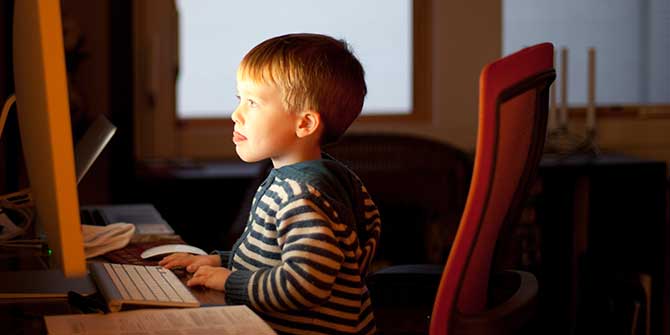The Effects of Digital Media on Child Development

In an era where screens dominate our daily lives, the impact of digital media on child development has become a pressing concern for parents and educators alike thus the need to ask what the Effects of Digital Media on Child Development: The effects of digital media on child development are multifaceted, encompassing both positive and negative outcomes. While educational apps and interactive content can enhance learning and creativity, excessive screen time can lead to issues such as attention deficits, sleep disturbances, and impaired social skills.
Imagine a world where a child’s first interactions are not with building blocks or picture books but with glowing screens and virtual environments.
This shift in early experiences can have profound implications, both positive and negative, on their cognitive, social, and emotional growth.
The allure of digital media is undeniable – it’s colorful, engaging, and readily available. Yet, beneath its captivating surface lies a complex web of effects that can shape a child’s development in unexpected ways.
Interest spikes when we delve into the nuances of how digital media can influence a child’s brain. Research reveals that while educational apps and interactive games can promote learning and creativity, excessive screen time can lead to attention problems, sleep disturbances, and hindered social skills.
Parents find themselves at a crossroads, wanting to harness the educational potential of digital media while protecting their children from its potential pitfalls. It’s a balancing act, one that requires awareness and intentionality.
Desire ignites as we envision a future where digital media serves as a powerful tool for enhancing child development, rather than detracting from it.
Consider the possibilities: children using technology to explore new concepts, develop critical thinking skills, and connect with peers across the globe.
This ideal scenario is within reach, but only if we approach digital media use with mindfulness and strategic planning.
Action calls us to reevaluate how we incorporate digital media into our children’s lives. By setting boundaries, choosing high-quality content, and encouraging a healthy balance between screen time and real-world activities, we can ensure that digital media becomes a beneficial part of our children’s developmental journey.
Let’s commit to understanding the effects of digital media on child development and take proactive steps to foster a harmonious relationship between our children and the digital world.
Understanding Digital Media
Digital media encompasses a vast array of platforms and devices, including computers, tablets, smartphones, and gaming consoles.
These tools provide access to the internet, social networks, educational resources, and entertainment. The ubiquity and versatility of digital media have revolutionized how children learn, communicate, and entertain themselves.
The proliferation of digital devices has led to a significant increase in screen time among children.
From a young age, children are exposed to digital media through educational programs, interactive games, and social platforms. This digital immersion has transformed traditional childhood experiences, presenting both opportunities and challenges.
Statistics on Children’s Digital Media Use
Recent statistics reveal that children spend an average of several hours per day on digital devices. According to Common Sense Media, children aged 8 to 12 spend about six hours a day on screens, while teenagers average nearly nine hours.
These figures underscore the pervasive presence of digital media in children’s lives and highlight the need for mindful consumption.
The Different Types of Digital Media Consumed by Children
Educational Media
Educational media includes apps, websites, and programs designed to enhance learning. These tools can support literacy, numeracy, and critical thinking skills. Platforms like Khan Academy and educational YouTube channels offer interactive and engaging content that complements traditional education.
Entertainment Media
Entertainment media encompasses video games, movies, and online videos. While these forms of media can provide relaxation and enjoyment, excessive consumption may lead to negative outcomes such as reduced physical activity and social interaction.
Social Media Platforms
Social media platforms like Instagram, TikTok, and Snapchat are popular among children and adolescents. These platforms facilitate communication and self-expression but also expose users to risks such as cyberbullying and privacy concerns.
Positive Impacts of Digital Media on Child Development
Enhancing Learning and Education
Digital media can significantly enhance learning by providing access to a wealth of information and educational resources. Interactive apps and online courses offer personalized learning experiences, making education more engaging and accessible.
Promoting Creativity and Self-Expression
Digital tools enable children to explore their creativity through activities such as digital drawing, video production, and music creation. Platforms like Minecraft and Scratch foster innovation and allow children to express themselves uniquely.
Building Technical Skills and Digital Literacy
Early exposure to digital media helps children develop essential technical skills and digital literacy. These competencies are increasingly important in a technology-driven world, preparing children for future academic and professional success.
Negative Impacts of Digital Media on Child Development
Impact on Attention Span and Focus
Excessive screen time can negatively affect attention span and focus. Rapidly changing visuals and constant notifications from digital devices can contribute to shorter attention spans and difficulties in concentrating on tasks.
Sleep Disruption and Its Consequences
The blue light emitted by screens can interfere with sleep patterns, leading to reduced sleep quality and duration. Insufficient sleep can adversely affect mood, cognitive function, and overall health.
Exposure to Inappropriate Content
Children may inadvertently access inappropriate content online, including violent or explicit material. This exposure can have detrimental effects on their mental and emotional well-being, highlighting the importance of parental monitoring and content controls.
The Role of Parents in Moderating Digital Media Use
Setting Screen Time Limits
Establishing clear screen time limits helps balance digital media use with other activities. The American Academy of Pediatrics recommends no more than one hour of screen time per day for children aged 2 to 5 and consistent limits for older children.
Choosing Age-Appropriate Content
Parents should ensure that the digital content their children consume is age-appropriate and educational. Using parental control settings and researching apps and programs can help in selecting suitable content.
Encouraging Balanced Media Consumption
Promoting a balanced approach to media consumption involves integrating digital activities with offline pursuits. Encouraging children to engage in hobbies, sports, and family interactions can foster a well-rounded lifestyle.
The Influence of Digital Media on Cognitive Development
Effects on Memory and Information Retention
While digital media can provide valuable information, it can also affect memory and retention. The ease of accessing information online may lead to superficial learning and reduced ability to recall details.
Influence on Problem-Solving Skills
Interactive digital games and puzzles can enhance problem-solving skills by challenging children to think critically and strategically. However, reliance on digital tools for problem-solving may impede the development of independent thinking skills.
Impact on Academic Performance
The relationship between digital media use and academic performance is complex. While educational media can support learning, excessive use of entertainment media can distract from homework and study time, potentially leading to lower academic achievement.
Digital Media and Emotional Development
Understanding Digital Empathy
Digital empathy involves understanding and sharing the feelings of others through digital interactions. While online communication can foster empathy, it may lack the depth and nuance of face-to-face interactions.
Impact on Emotional Regulation
The instant gratification provided by digital media can affect emotional regulation. Children may struggle with patience and impulse control, as they become accustomed to immediate responses and rewards.
Effects on Self-Esteem and Body Image
Social media can impact self-esteem and body image, as children compare themselves to idealized images and lifestyles. Encouraging critical thinking and promoting positive body image can mitigate these effects.
Social Development and Digital Media
The Role of Social Media in Friendship Formation
Social media platforms facilitate the formation and maintenance of friendships, allowing children to connect with peers beyond geographical boundaries. However, online interactions should complement, not replace, real-life social experiences.
Impact on Face-to-Face Communication Skills
Excessive digital communication can hinder the development of face-to-face communication skills. Children may struggle with interpreting non-verbal cues and engaging in meaningful conversations.
Cyberbullying is a significant concern, with harmful effects on mental health and well-being. Educating children about online safety and fostering open communication can help address and prevent cyberbullying.
Physical Health and Digital Media
Screen Time and Physical Activity
High screen time is often associated with sedentary behavior, reducing opportunities for physical activity. Encouraging regular exercise and outdoor play is essential for physical health.
Prolonged screen use can strain the eyes, leading to issues such as digital eye strain and myopia. Implementing the 20-20-20 rule—taking a 20-second break every 20 minutes to look at something 20 feet away—can alleviate eye strain.
Posture and Musculoskeletal Issues
Poor posture while using digital devices can lead to musculoskeletal problems, including back and neck pain. Encouraging proper ergonomics and regular breaks can prevent these issues.
Strategies for Healthy Digital Media Use
Creating a Media Use Plan for Families
A media use plan outlines guidelines for digital media consumption, including screen time limits and content choices. Involving children in creating this plan can foster cooperation and adherence.
Promoting Digital Detox Periods
Regular digital detox periods, where children engage in screen-free activities, can reduce dependency on digital media and promote overall well-being.
Encouraging Alternative Activities
Encouraging children to explore alternative activities such as reading, sports, and hobbies can provide a healthy balance to digital media use and support holistic development.
The Role of Schools in Digital Media Education
Integrating Digital Literacy into the Curriculum
Incorporating digital literacy into the school curriculum ensures that children develop essential skills for navigating the digital world safely and effectively.
Teaching Safe and Responsible Online Behavior
Educating children about safe and responsible online behavior, including privacy settings and respectful communication, is crucial for their digital well-being.
Collaborating with Parents to Manage Media Use
Schools and parents should work together to manage children’s media use, ensuring consistency between home and school environments.
Digital Media and Early Childhood Development
Impact on Language Acquisition
Interactive digital media can support language acquisition by providing exposure to vocabulary and language structures. However, passive consumption, such as watching videos, may not be as effective.
Influence on Play and Imagination
Digital media can influence play and imagination, both positively and negatively. While certain apps and games encourage creative play, excessive screen time can limit opportunities for imaginative offline play.
Effects on Parent-Child Interaction
Digital media use can affect parent-child interaction, sometimes enhancing it through shared activities and other times detracting from quality time. Mindful media use can ensure positive interactions.
Long-Term Effects of Digital Media Exposure
Research on Longitudinal Impacts
Longitudinal research provides insights into the long-term effects of digital media exposure on child development. Studies indicate both potential benefits and risks, emphasizing the need for balanced media use.
Potential Career Skills and Opportunities
Digital media exposure can equip children with skills relevant to future careers in technology and creative industries. Encouraging productive and educational use of digital tools can support career readiness.
Balancing Risks and Benefits
Balancing the risks and benefits of digital media involves mindful consumption, parental guidance, and the promotion of healthy habits. Understanding both sides helps in making informed decisions.
The Future of Digital Media and Child Development
Emerging Trends in Digital Media
Emerging trends in digital media, such as virtual reality and augmented reality, offer new possibilities for learning and entertainment. Staying informed about these trends can help guide their use.
Potential Advances in Educational Technology
Advances in educational technology hold the promise of enhancing learning experiences. Innovations such as adaptive learning platforms and immersive simulations can revolutionize education.
Ongoing Research and Policy Recommendations
Ongoing research and policy recommendations aim to optimize digital media use for child development. Supporting evidence-based practices and policies ensures the well-being of future generations.
Conclusion
Navigating the digital landscape requires a balanced approach to harness the benefits while mitigating the risks. By understanding the effects of digital media on child development and implementing mindful strategies, parents, educators, and policymakers can support the healthy growth of children in the digital age.
Additional Resources and Further Reading
For further information and support, consider exploring additional resources such as books, websites, and local mental health organizations dedicated to children’s well-being.









